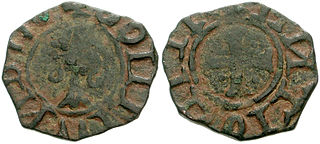
Theodore I Laskaris or Lascaris was the first emperor of Nicaea—a successor state of the Byzantine Empire—from 1205 to his death. Although he was born to an obscure aristocratic family, his mother was related to the imperial Komnenos clan. He married Anna, a younger daughter of Emperor Alexios III Angelos in 1200. He received the title of despot before 1203, demonstrating his right to succeed his father-in-law on the throne.

Henry was Latin emperor of Constantinople from 1205 until his death in 1216. He was one of the leaders of the Fourth Crusade in which the Byzantine Empire was conquered and Latin Empire formed.
Kaloyan or Kalojan, also known as Ivan I, Ioannitsa or Johannitsa, the Romanslayer, was emperor or tsar of Bulgaria from 1196 to 1207. He was the younger brother of Theodor and Asen, who led the anti-Byzantine uprising of the Bulgarians and Vlachs in 1185. The uprising ended with the restoration of Bulgaria as an independent state. He spent a few years as a hostage in Constantinople in the late 1180s. Theodor, crowned Emperor Peter II, made him his co-ruler after Asen was murdered in 1196. A year later, Peter was also murdered, and Kaloyan became the sole ruler of Bulgaria.

Bohemond IV of Antioch, also known as Bohemond the One-Eyed, was Count of Tripoli from 1187 to 1233, and Prince of Antioch from 1201 to 1216 and from 1219 to 1233. He was the younger son of Bohemond III of Antioch. The dying Raymond III of Tripoli offered his county to Bohemond's elder brother, Raymond, but their father sent Bohemond to Tripoli in late 1187. Saladin, the Ayyubid sultan of Egypt and Syria, conquered the county, save for the capital and two fortresses, in summer 1188.
Pelagio Galvani was a Leonese cardinal, and canon lawyer. He became a papal legate and leader of the Fifth Crusade.

Peter of Capua was an Italian scholastic theologian and prelate. He served as cardinal-deacon of Santa Maria in Via Lata from 1193 until 1201 and cardinal-priest of San Marcello al Corso from 1201 until his death. He often worked as a papal legate. He wrote several theological works and was a patron of his hometown of Amalfi.
Sicardus of Cremona (1155–1215) was an Italian prelate, historian and writer.
Pietro Gallocia or Galluzzi was a Roman cardinal.
Ottaviano di Poli, a member of the family of the Counts of Poli, was an Italian Roman Catholic Cardinal.
Nicholas Mesarites was a Byzantine Greek churchman and writer, who eventually rose to the office of Metropolitan of Ephesus in the Empire of Nicaea.
Berthold II von Katzenelnbogen was a German nobleman of the family of the Counts of Katzenelnbogen and a participant in the Fourth Crusade (1202–04), who became lord of Velestino (c.1205–17) and regent of the Kingdom of Thessalonica (c.1217) in Frankish Greece. He was a patron of poets and in politics a Ghibelline.

The War of the Antiochene Succession, also known as the Antiochene War of Succession, comprised a series of armed conflicts in northern Syria between 1201 and 1219, connected to the disputed succession of Bohemond III of Antioch. The Principality of Antioch was the leading Christian power in the region during the last decades of the 12th century, but Armenian Cilicia challenged its supremacy. The capture of an important fortress, Bagras, in Syria by Leo II of Cilicia gave rise to a prolonged conflict already in the early 1190s. Leo tried to capture Antioch, but the Greek and Latin burghers formed a commune and prevented the Armenian soldiers from occupying the town. Bohemond III's eldest son, Raymond, died in 1197, leaving an infant son, Raymond-Roupen. The boy's mother, Alice of Armenia, was Leo I's niece and heir presumptive. Bohemond III and the Antiochene noblemen confirmed Raymond-Roupen's right to succeed his grandfather in Antioch, but the commune preferred Bohemond III's younger son, Bohemond, Count of Tripoli.
Soffredo was an Italian cardinal. His name is also given as Soffredo Errico Gaetani, whilst his Christian name is also spelled Soffrido or Goffredo in some sources.
Eustace of Flanders or Eustace of Hainaut was a member of the House of Flanders, brother of the Latin Emperors Baldwin I and Henry, and regent of the Kingdom of Thessalonica in 1209–1216.
The Podestà of Constantinople was the official in charge of Venetian possessions in the Latin Empire and the Venetian quarter of Constantinople during the 13th century. Nominally a vassal to the Latin Emperor, the Podestà functioned as a ruler in his own right, and answered to the Doge of Venice. The Podestà was also officially known as Governor of One-Fourth and One-Half of the Empire of Romania and was entitled to wearing the crimson buskins as the emperors.

Peter was an Italian Cistercian monk and prelate. He was the abbot of Rivalta from 1180 until 1185, abbot of Lucedio from 1185 until 1205, abbot of La Ferté from 1205 until 1206, bishop of Ivrea from 1206 until 1208 and patriarch of Antioch from 1209 until his death. He is known as Peter of Magnano, Peter of Lucedio or Peter of Ivrea.
The timeline of the Latin Empire is a chronological list of events of the history of the Latin Empire—the crusader state that developed on the ruins of the Byzantine Empire after the Fourth Crusade in the 13th century.
John of Ferentino, in Italian Giovanni da Ferentino, was an Italian notary, curialist and cardinal of the Catholic Church. He served as the cardinal deacon of Santa Maria in Via Lata from 1204 until 1212 and then as the cardinal priest of Santa Prassede until his death. He served as an apostolic legate to England in 1206 and as rector of the Papal states in Campania in 1217.
Gerardo da Sesso was an Italian monk, bishop and cardinal of the Catholic Church.